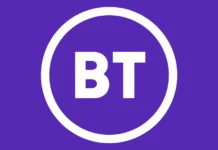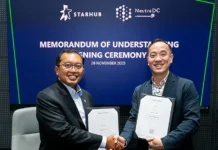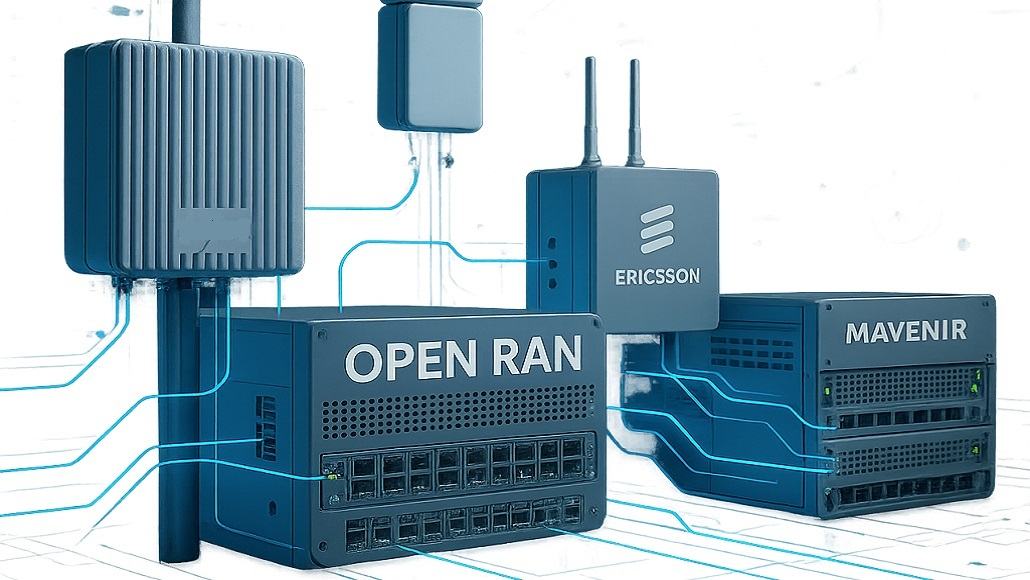Open RAN and Telecom Infrastructure in Asia-Pacific
The telecommunications infrastructure landscape across Asia-Pacific is undergoing a revolutionary transformation driven by Open Radio Access Network technology. This paradigm shift promises to democratize network deployment, reduce dependency on single vendors, and foster unprecedented innovation in mobile network architecture. With the global Open RAN market projected to reach $45.70 billion by 2032 from $2.92 billion in 2024, representing explosive growth of over 1,400%, Asia-Pacific emerges as a critical battleground for this technological evolution.
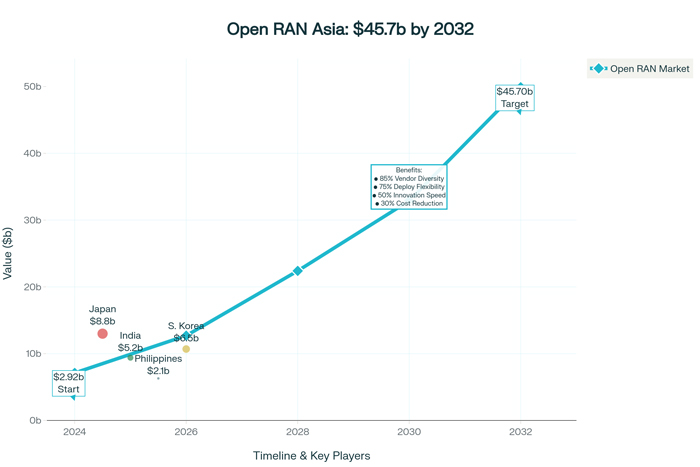
The Open RAN Revolution
Open RAN represents a fundamental departure from traditional proprietary network architectures by disaggregating hardware and software components while promoting vendor-neutral interoperability. This approach enables operators to mix and match components from different suppliers, creating more flexible, cost-effective, and scalable network infrastructures.
The technology’s appeal extends beyond technical benefits to encompass strategic advantages including reduced vendor lock-in, enhanced competition among suppliers, and accelerated innovation cycles. For Asia-Pacific operators facing intense cost pressures and rapid technology evolution, Open RAN offers a pathway to more sustainable network economics.
Market Dynamics and Growth Drivers
Regional Leadership
Asia-Pacific has positioned itself at the forefront of Open RAN adoption, driven by favorable government policies, technological prowess, and strong digital transformation initiatives. Japan leads regional development through substantial government investment and strategic industry collaboration, while South Korea and India follow with aggressive deployment strategies.
Japan’s commitment includes an 8.8 billion euro development fund and the Beyond 5G Consortium, mobilizing public-private partnerships to establish global leadership in next-generation connectivity. This comprehensive approach encompasses research, standardization, and commercial deployment initiatives.
Government Support and Strategic Initiatives
The United States government actively supports Open RAN development in Asia-Pacific through USAID and the U.S. Trade and Development Agency, providing technical assistance and funding to encourage adoption. The Asia Open RAN Academy, established in 2023 as part of the Indo-Pacific Economic Framework, represents a collaborative effort to advance open, interoperable, and secure digital ecosystems.
This international cooperation extends to the establishment of Open RAN laboratories and training facilities. The University of the Philippines Diliman hosts an Open RAN Lab supported by USAID’s Better Access and Connectivity project, designed to enhance economic growth through improved internet infrastructure.
Technology Implementation and Deployment Models
Disaggregated Architecture Approach
Open RAN’s technical foundation rests on disaggregated network components including Radio Units, Centralized Units, Distributed Units, and RAN Intelligent Controllers. This architecture enables multiple deployment models ranging from fully integrated solutions to completely distributed implementations.
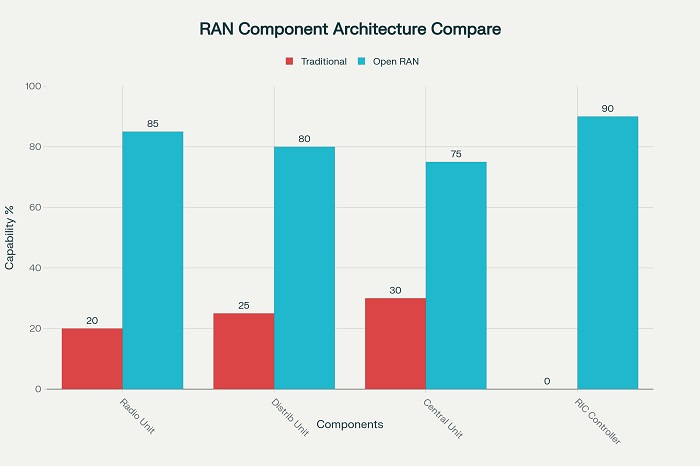
The flexibility inherent in Open RAN architecture allows operators to choose optimal configurations for specific deployment scenarios. This includes bare metal implementations, virtualized platforms, and containerized solutions that support diverse operational requirements.
Standards and Interoperability
The Telecom Infra Project’s OpenRAN initiative drives standardization efforts across 2G, 3G, 4G, and 5G networks. Key technical specifications focus on open interfaces between components, enabling vendor-neutral hardware and software integration.
These standardization efforts address critical industry needs including supply chain diversity, rapid innovation adoption, and performance improvement through automation and competition. The resulting ecosystem promotes abundant last-mile wireless connectivity through vibrant, continuously innovating technology stacks.
Regional Market Development
Philippines: Early Adoption Success
The Philippines demonstrates Open RAN’s practical implementation potential through Smart Communications’ deployment of the country’s first fully operational Open RAN Proof of Concept in partnership with NTT DOCOMO. This milestone validates Open RAN’s viability in emerging markets where traditional network solutions have been cost-prohibitive.
The success in the Philippines creates a template for broader Southeast Asian deployment, particularly in markets seeking network diversification and enhanced connectivity in rural areas. U.S. government support through technical assistance and funding accelerates adoption while strengthening bilateral relationships.
Japan: Technology Leadership
Japan’s Open RAN industry development benefits from favorable government initiatives and strategic partnerships among major technology providers. KDDI Corporation’s collaboration with Samsung and Fujitsu to deploy 5G Open Virtual RAN sites demonstrates commercial viability and performance optimization.
Japanese operators leverage Open RAN to enhance network efficiency and prepare for 6G transition while maintaining technological leadership. This approach positions Japan as a global reference point for Open RAN best practices and commercial success.
India: Scale and Innovation
India’s Open RAN market experiences rapid growth driven by leading operators including Bharti Airtel, Reliance Jio, and Vodafone Idea. Reliance Jio’s deployment across its nationwide 4G network and 5G preparation demonstrates Open RAN’s scalability in massive markets.
The Indian market’s size enables volume-driven cost reductions while creating opportunities for domestic technology development and manufacturing. This ecosystem approach supports both immediate deployment needs and long-term strategic independence.
Economic and Competitive Advantages
Cost Optimization
Open RAN’s disaggregated architecture enables significant cost reductions through vendor competition and operational flexibility. Operators can optimize procurement by selecting best-of-breed components while avoiding vendor lock-in premiums.
The competitive dynamics introduced by Open RAN force traditional vendors to reduce prices while encouraging new market entrants. This increased competition benefits operators through lower equipment costs and enhanced negotiating power.
Innovation Acceleration
Open RAN’s modular architecture facilitates rapid technology adoption and deployment of new features. Operators can introduce innovations without comprehensive network overhauls, reducing time-to-market for new services and capabilities.
The ecosystem’s openness encourages collaboration between equipment providers and network operators, fostering innovation through shared development efforts. This collaborative approach accelerates problem-solving and solution development across the industry.
Strategic Implementation Challenges
Technical Complexity
Open RAN deployment requires sophisticated integration capabilities and comprehensive testing to ensure seamless interoperability. Operators must develop expertise in managing multi-vendor environments while maintaining network performance and reliability.
The complexity of integrating components from different suppliers necessitates robust system integration capabilities and ongoing vendor management. This requirement may challenge smaller operators lacking extensive technical resources.
Security Considerations
Open RAN networks introduce new security considerations through increased system complexity and multiple vendor interactions. Operators must implement comprehensive security frameworks that address potential vulnerabilities across disaggregated components.
The multi-vendor environment requires enhanced security protocols and monitoring capabilities to maintain network integrity. This security imperative drives additional investment in security technologies and operational procedures.
Future Development Trajectory
5G Advanced Integration
Open RAN’s evolution incorporates 5G Advanced capabilities including enhanced network slicing, improved energy efficiency, and AI-driven optimization. Telstra and Ericsson’s deployment of Asia-Pacific’s first programmable 5G network with Open RAN-ready hardware demonstrates advanced capability integration.
These developments enable operators to leverage Open RAN architecture for next-generation services while maintaining flexibility for future technology adoption. The programmable network approach supports API-driven service development and external innovation.
6G Preparation
Open RAN’s flexible architecture positions operators advantageously for 6G transition by enabling gradual technology adoption without comprehensive infrastructure replacement. The disaggregated approach supports evolving technology requirements while preserving investment value.
Southeast Asian countries including Vietnam, Singapore, and Malaysia leverage Open RAN deployment experience to prepare for 6G standardization and implementation. This preparation ensures regional competitiveness in next-generation network development.
The Open RAN transformation across Asia-Pacific represents more than technological evolution; it embodies a strategic shift toward more competitive, innovative, and cost-effective network infrastructure. Operators embracing this transformation position themselves advantageously for sustainable growth in increasingly competitive markets. Success requires comprehensive planning, technical expertise, and strategic partnerships, but the potential benefits justify the investment through enhanced operational flexibility, reduced costs, and accelerated innovation capabilities.
The region’s leadership in Open RAN adoption creates opportunities for technology export and knowledge transfer to other global markets while establishing Asia-Pacific as a center of excellence for next-generation network technologies. This strategic positioning supports long-term competitiveness in the evolving telecommunications landscape.


